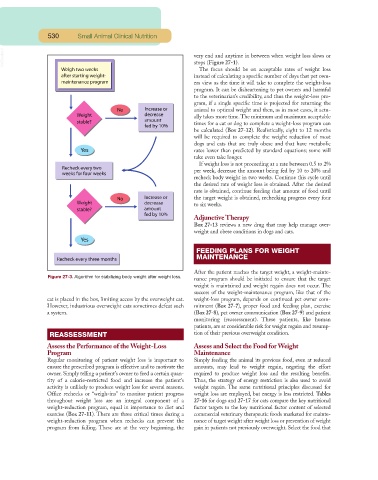Page 514 - Small Animal Clinical Nutrition 5th Edition
P. 514
530 Small Animal Clinical Nutrition
VetBooks.ir very end and anytime in between when weight loss slows or
stops (Figure 27-1).
The focus should be on acceptable rates of weight loss
instead of calculating a specific number of days that pet own-
ers view as the time it will take to complete the weight-loss
program. It can be disheartening to pet owners and harmful
to the veterinarian’s credibility, and thus the weight-loss pro-
gram, if a single specific time is projected for returning the
animal to optimal weight and then, as in most cases, it actu-
ally takes more time.The minimum and maximum acceptable
times for a cat or dog to complete a weight-loss program can
be calculated (Box 27-12). Realistically, eight to 12 months
will be required to complete the weight reduction of most
dogs and cats that are truly obese and that have metabolic
rates lower than predicted by standard equations; some will
take even take longer.
If weight loss is not proceeding at a rate between 0.5 to 2%
per week, decrease the amount being fed by 10 to 20% and
recheck body weight in two weeks. Continue this cycle until
the desired rate of weight loss is obtained. After the desired
rate is obtained, continue feeding that amount of food until
the target weight is obtained, rechecking progress every four
to six weeks.
AdjunctiveTherapy
Box 27-13 reviews a new drug that may help manage over-
weight and obese conditions in dogs and cats.
FEEDING PLANS FOR WEIGHT
MAINTENANCE
After the patient reaches the target weight, a weight-mainte-
Figure 27-3. Algorithm for stabilizing body weight after weight loss.
nance program should be initiated to ensure that the target
weight is maintained and weight regain does not occur. The
success of the weight-maintenance program, like that of the
cat is placed in the box, limiting access by the overweight cat. weight-loss program, depends on continued pet owner com-
However, industrious overweight cats sometimes defeat such mitment (Box 27-7), proper food and feeding plan, exercise
a system. (Box 27-8), pet owner communication (Box 27-9) and patient
monitoring (reassessment). These patients, like human
patients, are at considerable risk for weight regain and resump-
REASSESSMENT tion of their previous overweight condition.
Assess the Performance of the Weight-Loss Assess and Select the Food for Weight
Program Maintenance
Regular monitoring of patient weight loss is important to Simply feeding the animal its previous food, even at reduced
ensure the prescribed program is effective and to motivate the amounts, may lead to weight regain, negating the effort
owner. Simply telling a patient’s owner to feed a certain quan- required to produce weight loss and the resulting benefits.
tity of a calorie-restricted food and increase the patient’s Thus, the strategy of energy restriction is also used to avoid
activity is unlikely to produce weight loss for several reasons. weight regain. The same nutritional principles discussed for
Office rechecks or “weigh-ins” to monitor patient progress weight loss are employed, but energy is less restricted. Tables
throughout weight loss are an integral component of a 27-16 for dogs and 27-17 for cats compare the key nutritional
weight-reduction program, equal in importance to diet and factor targets to the key nutritional factor content of selected
exercise (Box 27-11). There are three critical times during a commercial veterinary therapeutic foods marketed for mainte-
weight-reduction program when rechecks can prevent the nance of target weight after weight loss or prevention of weight
program from failing. These are at the very beginning, the gain in patients not previously overweight. Select the food that

